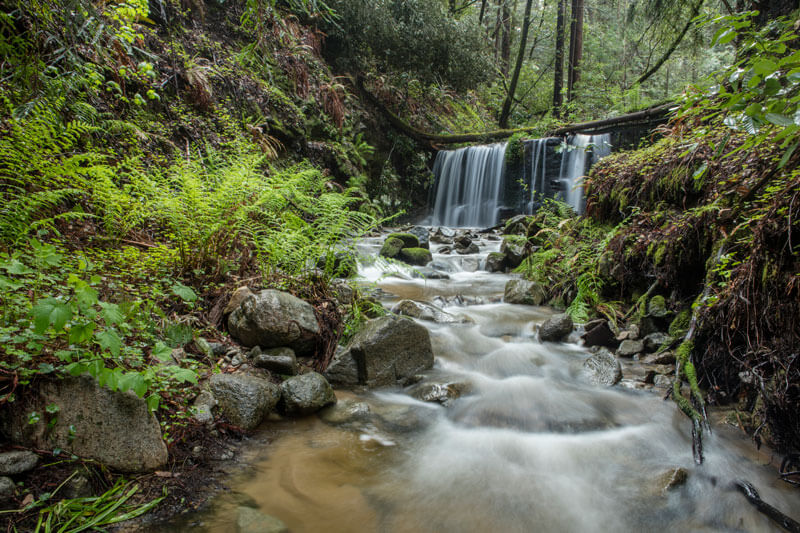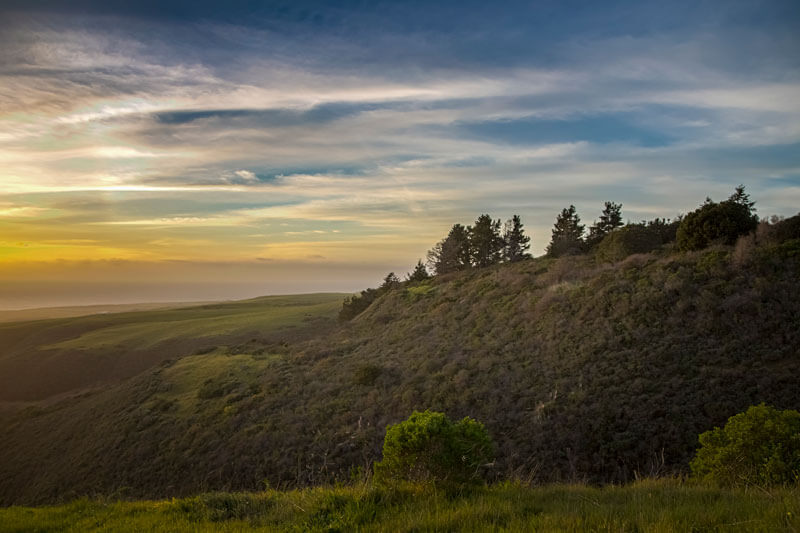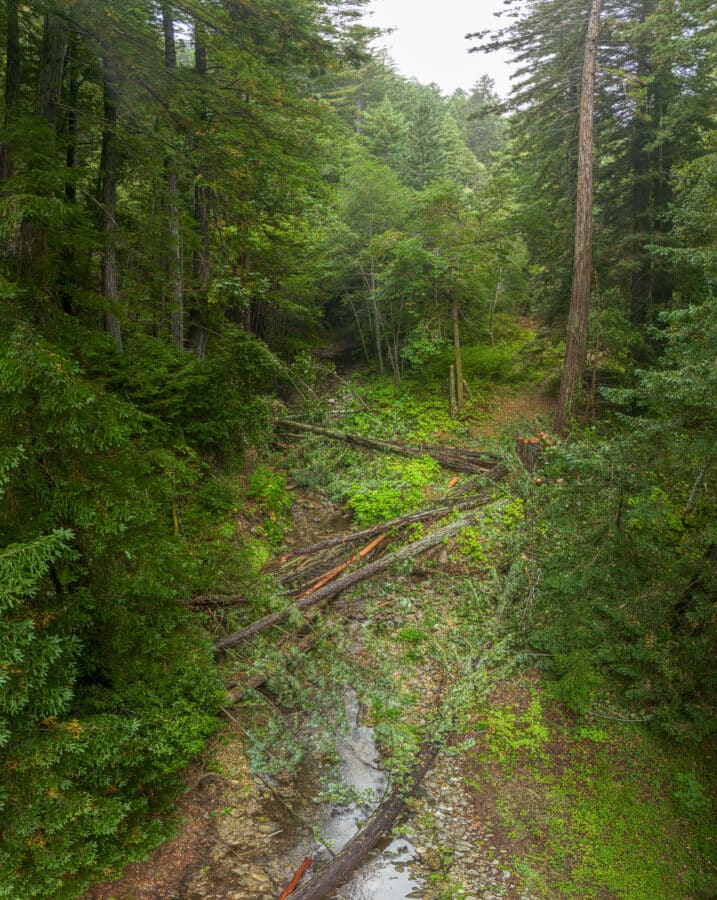Forest Stewardship: Creek to Sea
Mapping the role and route of water in the redwood ecosystem
Our Stewardship team lives and breathes redwoods—which means caring for all the plants and animals that call this unique forest home, including two you might not always associate with the forest: coho salmon and steelhead trout. As we mark the four-year anniversary of the Mill Creek dam removal, we’re celebrating new signs of hope for coho and the interconnected habitats of the Santa Cruz Mountains—from creek to sea—exploring how they support one another, and how we support them.
San Vicente Redwoods and Mill Creek
It sometimes shocks people that fish can be found in a redwood forest, but the creeks of the Santa Cruz Mountains were once rich with coho salmon and steelhead trout.
Today, the coho salmon population is under threat. There are many causes for this: outdated logging practices, deforestation, development, and water extraction for farming and residences are all factors. Recently, climate change has become a new threat. Devastating wildfires, such as the CZU Lightning Complex, can cause severe damage to the riparian habitat.

From 2021, before the Mill Creek Dam was removed. The defunct dam stood for more than a century. Photo by Ian Bornarth.
Four years ago, in October 2021, we partnered with the Resource Conservation District of Santa Cruz County to remove the Mill Creek Dam—a big impediment for salmon. Dams reduce salmon access to critical waterways and, especially in this case, the gravelly sediment that establishes critical spawning beds.
Dams are uncommon in the Santa Cruz Mountains; the one at Mill Creek was built in the last century to support redwood logging, but it was poorly planned and immediately defunct. But there it sat for a century, clogging the creek. The removal of the dam was a major milestone for the creek and for our team it opened the door to advanced stewardship1 practices that will help restore this watershed and support the ecosystem.
Supporting the creek helps, in turn, to support the watershed that it is born from. The watersheds of the Santa Cruz Mountains require extra care given all the life they support. This care comes in many forms and stewardship activities: decommissioning rural dirt roads, implementing water bars (dirt humps on roads), clearing culverts before, during, and after rainfall, and minimizing vehicle activity during the wet season.
"Removing the dam took years of planning and permits but the dam came down in a matter of minutes. But what came next was spectacular. Winter storms reformed the creek bed and immediately moved a century of granite cobble downstream. And a year later, the coho returned." —Beatrix Jiménez-Helsley, Natural Resource Manager at Sempervirens Fund
Before and since the removal of the Mill Creek Dam, we have undertaken a number of other stewardship projects in the area to support salmonid life and breeding. Our restoration efforts began in 2017, with our stewardship team felling trees to improve instream habitat. In 2018, we began a large-scale effort to remove invasive plant species in the area, focusing specifically on Clematis vitalba (commonly known as “old-man’s beard”)—a climbing vine that was choking out the riparian and forest habitat.
In 2022, we recorded 15 juvenile coho salmon downstream and 12 juvenile steelhead trout. We can’t confirm they will all mate and survive, but the numbers are promising. This year, we have placed 111 more large woody debris structures—10 times the number placed before—to further improve the creek environment for these important fish.
Recently, baby redwoods have been spotted growing near Mill Creek—proof that the dam’s removal is beginning to support the next generation of life in these sacred forests.
BLM Land and the Start of the Lower San Vicente Creek Watershed
Heading southwest from Mill Creek, our Stewardship team makes a stop at a patch of land owned by the Bureau of Land Management. Here, they will remove the invasive Cape Ivy (Delairea odorata), a highly aggressive, non-native invasive plant with a growth rate of 20 feet, in all directions, per year. Cape Ivy smothers the redwood canopy and understory, which in turns prevents the establishment of tree saplings and other native species, resulting in a loss of understory plant diversity.
Without room for native plants to grow, native fish, amphibians, and other riparian species suffer, as there are fewer meals for the macroinvertebrates that they eat. In addition, the plant is mildly toxic and can be directly harmful to insects and wildlife, further reducing the diversity and health of wildlife and aquatic species. In short, an invasive plant like Cape Ivy can send repercussions down to the very bottom of the food chain.
"Cape Ivy vines can grow at rates exceeding 1-2 meters a month in all horizontal directions once it has established roots and 2-4 meters when growing vertically towards the light," explains George McMenamin, a Restoration Consultant based in Boulder Creek. "This allows it to rapidly form a dense ground cover of greater than 90% over large areas."
Not only does it prevent the establishment of new tree saplings and shrubs, but it also prevents the growth of many other native plant species resulting in a significant loss of understory plant diversity, including herbaceous plants. This loss of plant diversity leads to reductions in the diversity and numbers of in macro invertebrates resulting in a greater loss of food for fish, frogs and other riparian animal species.
"Because you need to remove every piece of the plant to control, you need a patient and talented crew and an expert supervisor," says Kelli Camara, Consulting Technical Director at the Resource Conservation District of Santa Cruz County. "Native plants can co-exist with Cape Ivy to some degree and in those areas we try to avoid impacting the native plants, which makes the removal of Cape Ivy even more time consuming and labor intensive."
Cape Ivy climbs over and smothers low growing native vegetation, disrupting food webs, reducing plant diversity and the quality of food and cover for our native wildlife that evolved with plants endemic to our area. "It also prevents the establishment of new tree sapling and trees are needed to provide shade, cover and food, and ultimately need to fall into the creek to maintain the health of our streams for fish and wildlife," says Camara.
Cotoni-Coast Dairies

The San Vicente watershed flows through Cotoni-Coast Dairies to the Pacific Ocean. Photo by R. Rymer
Sitting on the edge of the coast is a property known as Cotoni-Coast Dairies, an area with a rich ecosystem, boasting a rich diversity of native plants such as red alder and the endemic Monterey cypress and wildlife like the threatened California red-legged frogs, mountain lions, and of course, coho salmon and steelhead trout.
With the vast Pacific Ocean on one side and the redwoods of the Santa Cruz Mountains on the other, one can easily connect the dots and begin to trace the salmon’s journey from the interior forest to the ocean. At Cotoni-Coast Dairies, the two forested creeks—the Lower San Vicente Creek and Mill Creek—run and then meet before they empty into the sea; coho salmon follow these streams that flow downstream into the Pacific Ocean in order to grow from adolescence as a smolt into an adult fish, ready to mate and then, migrate to the sea’s rich smorgasbord to feed.
The Lower San Vicente Creek is unique. It no longer has a bar-built estuary, because the creek was rerouted in 1906 to make way for a railway access trestle. Without the estuary, fish can swim in or out of the stream any time of the year–the only regional watershed with this feature.
Additionally, its karst geology—a term that indicates that the bedrock has dissolved enough to create streams, creeks, or sinkholes—leads to higher and colder flows than in nearby watersheds, even during severe droughts.
Water and watersheds are critical for all living things on earth, and the ones that exist in the Santa Cruz Mountains are exceptional and special—another reason we work to protect this place. In much of the stewardship work we do throughout the watersheds of the Santa Cruz Mountains, we aim to restore the area to what it once was, before the influence of human development.
Our hope is that the creeks and streams, when allowed to flow freely and without impediment, will connect to the grand Pacific Ocean, and that the positive effects of our work will extend far beyond the coast of California.
1 Sempervirens Fund intentionally uses the term stewardship, rather than management, to describe our work. Stewardship recognizes the collaborative, culturally aware ways that we work to preserve and protect redwood forests; management implies top-down control. Stewardship also affirms our holistic approach, and recognizes the importance of not just the redwoods themselves, but the watersheds, understory, and entire ecosystems that nurture them.

